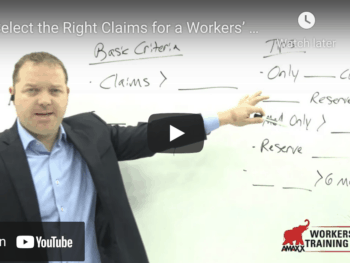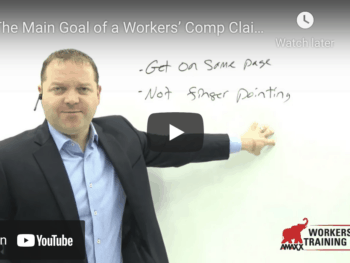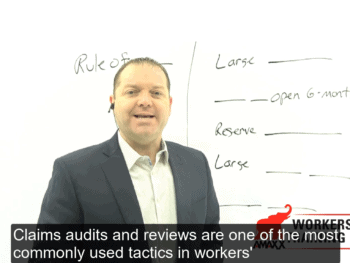This post is one in a 3-part series:
Click Link to Access Free PDF Download
“Workers’ Comp Claims Review Checklist: 9 Must-Have, Serious-Impact Elements”
Using claims audits and reviews is one of the most commonly used tactics in the war cop industry to reduce costs. Hello, my name is Michael Stack and I’m the CEO of Amaxx. And this is the third part of my little mini series. How to get the most value out of the time we’re investing in worker’s comp claims, audits and reviews. We’re doing it anyway. Let’s make that time valuable. Let’s make that time effective. Let’s get a return on that investment that we’re making into these claims audits and reviews to actually make a difference. And the first part of our series, I talked about mindset avoiding the blame game, working together as a team. The second part of our series, I talked about which claims to select which claims are selecting. Let’s go into this audit. Now you perform the audit. Now what happens after what happens after?
80% of the Time Nothing Changes
I will tell you what happens after, and probably, you know, 80% of the time, what happens? Nothing, nothing happens 80% of the time. Vast majority of the time we spend this time, we invest in it. We do the reports, the justice spent all the time preparing for it. Everyone comes to the table, you have a little yap session. And then everyone goes back to their cars and the report just goes up on a shelf or it gets saved in a file on someone’s computer. And it’s never opened and never actually makes a dent or an improvement in a work comp program to reduce costs and improve outcomes for the injured worker. I talked about that mindset in the first part of this series, as far as how important that is, that this is an invaluable time to come together as a claims handling team to order to make some improvements.
Continue the Conversation
And here’s what needs to happen after, in order to make that time invested valuable. You need to continue the conversation. So continue the conversation. You go back to your corners, but you still connect. You still talk about, you know, we were looking at this claim and we, we, you know, we looked at a number of claims and we kept seeing the same thing, you know, over and over. We’re having a really big problem maybe with lag time or we’re having a really big problem with return to work. And, you know, the adjusters are trying to coordinate this, but the employer side doesn’t have jobs available. And we think we can improve that. We think we can get better as a team using our better communication. Okay. So continue that conversation. The next claim comes up or that the open claims that are up, how do we work through that?
How do we continue the conversation? No, the names of the people on your team, you should get together with them. You’re connecting these adjusters. Who are your adjusters? What are their names? Who’s the supervisor, who’s the contact at the employer? How do you work together as a team to continue this conversation? Continue this conversation that you had when you went into this claims audit, as far as improving the, improving the processes, improving the workflows. If you have the right mindset going into this, if you pick the right claims, if you come up with some valuable conclusions, which you will, if you’re going through this as a team, then just continue the conversation after that claims review is done. And until that next time you have that formal review, you’ve had little mini conversations, a whole bunch of them all along the way. And then the next time, whether it’s, you know, you’re doing it four times a year, once a quarter, you’re doing, you know, twice a year, you’re doing it annually.
Plan to Make the Time Invested Valuable
Whatever the timeframe is for you, that’s appropriate. We recommend more frequently than less, but whatever is appropriate for you. You’ve had a bunch of little mini conversations in between, and that’s just a continuously improving process. As I said, claims audits and reviews are one of the most commonly used tactics by companies and organizations to reduce their workers’ comp costs and improve their systems. But what happens most of the time with these is it’s a huge waste of time is if we put all this time and effort into it, but 80% of the time, roughly speaking, nothing improves, and it’s just a blame game and it just causes frustration. And it just causes a huge waste of time. If we’re doing these things anyway, let’s plan for them properly, let’s have the right mindset, let’s select the right claims and let’s do something with it after it’s done. And we will see dramatically improved workers’ comp claim costs and outcomes. Again, my name is Michael stack. I’m the CEO of Amaxx. And remember your work today in workers’ compensation can have a dramatic impact on your company’s bottom line, but it will have a dramatic impact on someone’s life.
So, be great.
 Author Michael Stack, CEO Amaxx LLC. He is an expert in workers’ compensation cost containment systems and helps employers reduce their workers’ comp costs by 20% to 50%. He works as a consultant to large and mid-market clients, is a co-author of Your Ultimate Guide To Mastering Workers Comp Costs, a comprehensive step-by-step manual of cost containment strategies based on hands-on field experience, and is the founder & lead trainer of Amaxx Workers’ Comp Training Center, which offers the Certified Master of Workers’ Compensation national designation.
Author Michael Stack, CEO Amaxx LLC. He is an expert in workers’ compensation cost containment systems and helps employers reduce their workers’ comp costs by 20% to 50%. He works as a consultant to large and mid-market clients, is a co-author of Your Ultimate Guide To Mastering Workers Comp Costs, a comprehensive step-by-step manual of cost containment strategies based on hands-on field experience, and is the founder & lead trainer of Amaxx Workers’ Comp Training Center, which offers the Certified Master of Workers’ Compensation national designation.
Contact: mstack@reduceyourworkerscomp.com.
Workers’ Comp Roundup Blog: https://blog.reduceyourworkerscomp.com/
©2021 Amaxx LLC. All rights reserved under International Copyright Law.
Do not use this information without independent verification. All state laws vary. You should consult with your insurance broker, attorney, or qualified professional.

















